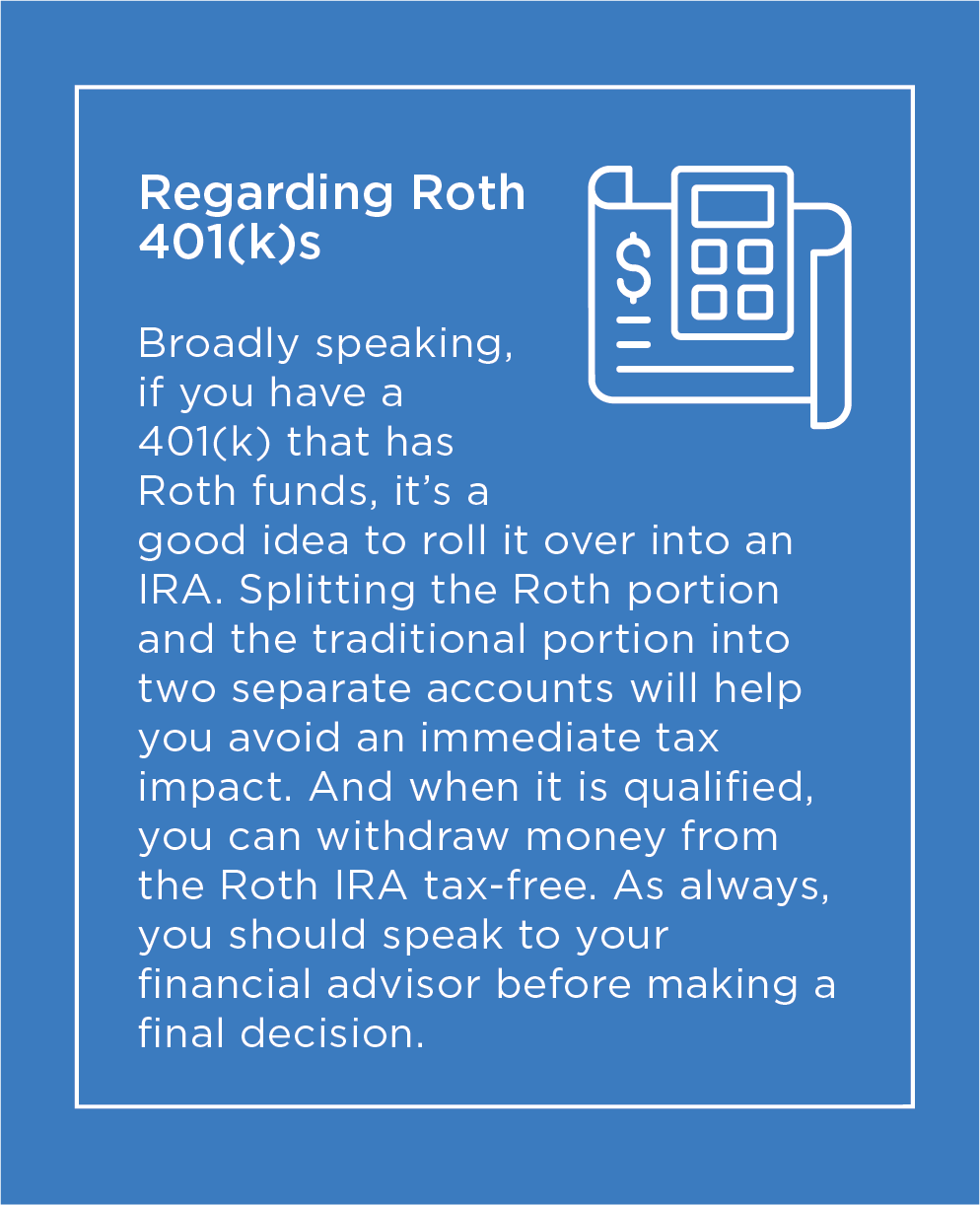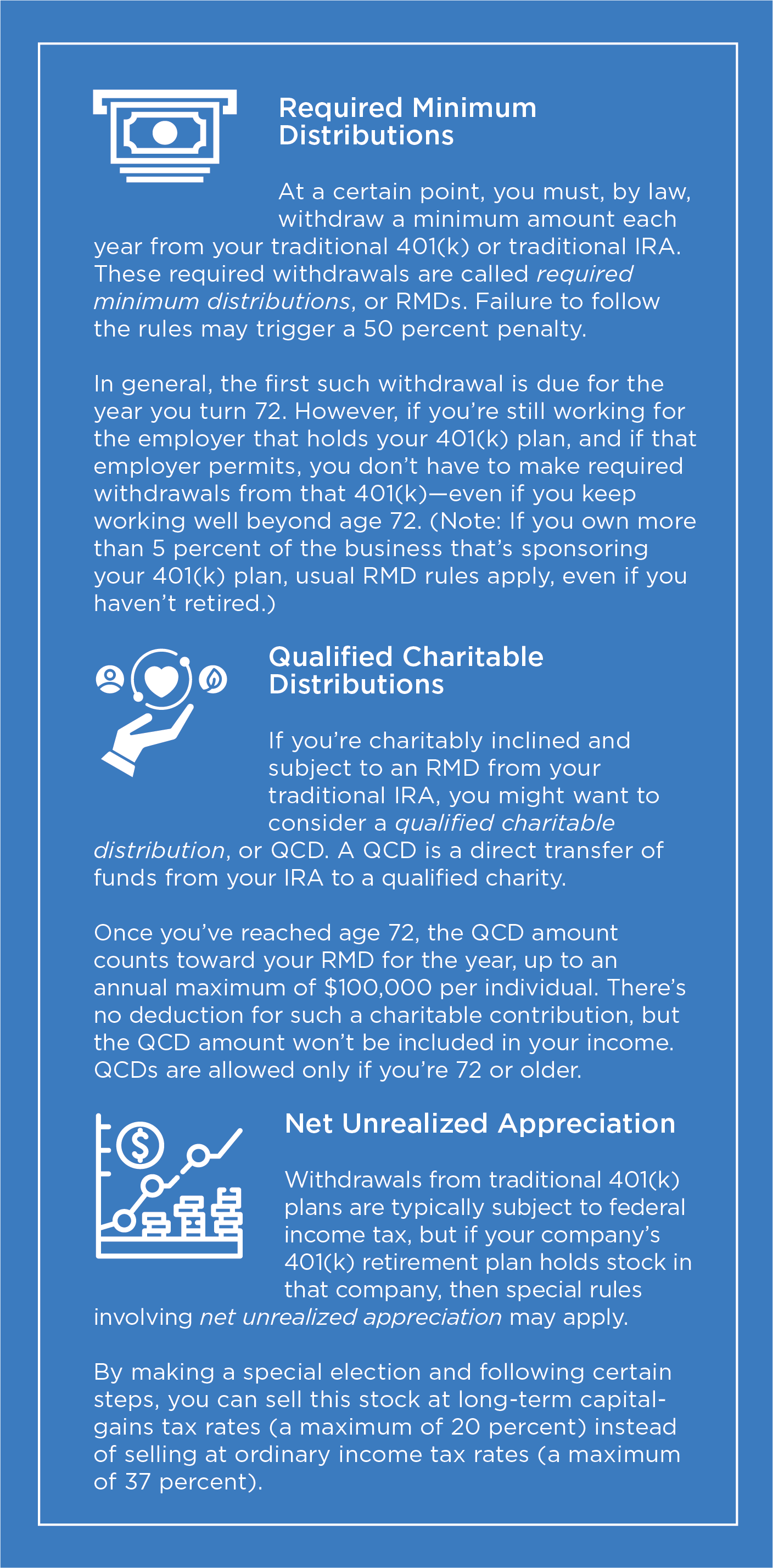Retiring Your 401(k)
Note: Although there are several types of tax-favored employer- sponsored retirement savings plans, this article focuses mainly on 401(k) plans because of their widespread use. Most of the following also applies to 403(b) plans and Roth-designated 401(k)s, but these plans will have extra features to consider. Before you take any action regarding your retirement funds, speak to your financial advisor about your specific case.
What should you do with your 401(k) when you retire? Broadly speaking, you have two tax-smart options: Stay in your plan, or move the money to an individual retirement account (IRA). Which approach is right for you depends on your circumstances, says Philip D’Unger, a manager on the CAPTRUST wealth planning team. For either path, there are multiple factors you should keep in mind, including investment options, taxes, and recordkeeping.
Staying in Your Plan
Assuming your employer allows for this option, you can choose to keep your 401(k) account in your employer’s plan. There are lots of potential benefits to staying in your plan. For one thing, there are no immediate tax consequences, says Jennifer Wertheim, a director of tax at CAPTRUST. “Tax deferral is always an option unless you take the money directly,” she explains. There can be other advantages too.
For example:
- You may already be comfortable with the plan and know how it works, so you don’t have to make any changes.
- You may be able to access more affordable mutual fund options in your employer’s plan.
- Generally, 401(k) plans provide greater protection from the claims of creditors than IRAs.
- You may be able to access the money in your account without the usual 10 percent early-withdrawal penalty if you retire or otherwise separate from service and you’re 55 or older (age 50 for public safety employees).
But there are also potential disadvantages to staying in your plan, including the following:
- Your employer may limit your investment options, offer only expensive options, or reduce the investment options you have access to after retirement.
- Aspects of your plan could change, including your investment options, if your employer undergoes a merger or acquisition.
- You won’t be able to continue making contributions.
Moving to an IRA
Another option is to move—or roll over—your account balance to a traditional IRA. Depending on the circumstances, you may be able to transfer the money directly from your 401(k) to an IRA. In other cases, your employer will send you a check for the entire amount. Then it becomes your responsibility to redeposit the funds into your IRA.
There are several benefits to an IRA. IRAs typically offer more flexibility and investment options than 401(k)s. Many financial services companies, including registered investment advisors, banks, and mutual fund companies, offer IRAs. And if you have had multiple 401(k) plans through multiple employers, you can consolidate them into a single account.
With an IRA, you typically can get access to your funds when you want, though tax rules still apply, and you have greater control of your saved money.
You can set up any number of IRAs and designate one beneficiary for each one. But with a 401(k), you are typically allowed to designate only one beneficiary for your account. That means, from an estate-planning perspective, an IRA may offer more flexibility.
You may want to use part of your IRA assets to buy an immediate annuity. The annuity option generally pays you a fixed amount throughout your life, says Gal Wettstein, a senior research economist at the Center for Retirement Research at Boston College. Note that a federal law enacted in 2019 generally lets 401(k) plans provide annuity income options too, but some plans may not offer the option—or may not offer it yet.
There are also some disadvantages to an IRA. For instance, you’ll need to pay attention to specific time windows for completing the rollover, and if you miss them, you’ll have to pay the tax consequence.
D’Unger says some 401(k) plans he’s worked with are “incredibly flexible” and generally let you do what you want, when you want. Some plans won’t let you keep your 401(k) account in place once you retire or otherwise separate from service, but other plans may let you make partial or systematic withdrawals. In brief, it pays to be familiar with all of your plan’s rules and how they work, he says.

Mind the Rules
If you plan to move your money to an IRA, be sure to follow the proper procedure. For example, if your plan sends you a lump- sum check, make sure that the check is not made payable solely to you. If it is, you could be taxed on the entire amount, including the 20 percent that your employer typically withholds for taxes.
To avoid such complications, ask that the check be made payable to your financial institution for your benefit, Wertheim says. Technically, the check may be made payable to the custodian or trustee that oversees your IRA, using the initials FBO (meaning for the benefit of). For instance, a check might be made payable to “Trustee of Plan X, for the benefit of Alice Smith” or “Institution Z, FBO Alice Smith’s IRA.”
Don’t sign or cash the check. Instead, forward it to your IRA or new employer’s plan. It’s a good idea to consult your IRA provider or new retirement plan to see what procedures are required in such cases. The point is to avoid immediate tax consequences, thus allowing your money to keep growing on a tax-free basis until you begin withdrawals.
Whether your plan sends the money directly to your IRA or sends you a check with an FBO, as described previously, it’s considered a direct rollover and no immediate tax consequences will ensue. Wertheim says she recommends direct rollovers “because there’s less room for errors.”
Check with your 401(k) plan provider and your IRA to be sure you are taking the right steps in the right order.
Middle of the Road
Another option is to move some of your money from your 401(k) to an IRA and leave the rest of the money in the plan. This means more recordkeeping for you but still may suit your current circumstances.
You might also consider leaving your nest egg inside your 401(k) temporarily, until you make a final decision. In other words, there’s no need to rush. Take your time to explore IRA options, comparing features such as investment options and fees.
Cashing Out
At retirement, many people feel tempted to take a lump-sum payment and cash out their retirement savings. But cashing out may not be your best bet. For one thing, you’ll miss out on the potential for your nest egg to keep growing.
Also, if you have a traditional, pre-tax 401(k), the entire amount will be taxed as ordinary income at federal tax rates of up to 37 percent, says Wertheim. Depending on where you live, state and local taxes may also take a bite. Thus, in what seems like the blink of an eye, a big chunk of your savings can disappear.
Although it ultimately depends on your situation, cashing out is generally “not a good choice,” D’Unger says.
Bridge to Social Security

One final strategy to consider: Use periodic withdrawals from your 401(k) to serve as an income resource—a bridge—until you finally start collecting Social Security benefits. Underlying the bridge strategy is a key point about Social Security benefits. The longer you wait to start collecting your monthly benefit, the higher the amount of that benefit will be. That means, in effect, you could use the bridge strategy to ensure a higher Social Security benefit later on, says Wettstein.
The following example shows how this bridge might work. Suppose you were born in early 1955 and earned enough money in your working years to start collecting a $3,100 monthly Social Security retirement benefit at 65 years old. If you instead wait until you are 68 years old to start collecting, then your monthly benefit might be closer to $3,800—$700 a month more.
If you need a source of income in the meantime—a way to make up for the money you did not collect from Social Security—you could use your 401(k) or other such account as a bridge, withdrawing money every month.
While this example is intentionally broad, relying on numerous assumptions that may not precisely fit your situation, the bridge option is worth considering.
When you retire, what you do with your traditional, pre-tax 401(k) account generally comes down to two options: Leave it in your employer’s plan, or move it to a traditional IRA. There are advantages and disadvantages to each. “There is no one-size-fits-all solution. It depends on what you’re trying to accomplish,” says D’Unger.
His advice: Start weighing the factors long before you retire so you don’t feel tempted to rush. Also, consider talking with your financial and tax advisors to ensure you choose the solution that’s right for you.